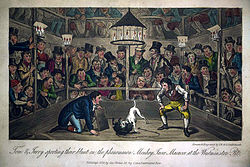This is an old revision of this page, as edited by Quartershadows (talk | contribs) at 11:58, 21 November 2010 (Undid revision 395738035 by Hipocrite (talk)). The present address (URL) is a permanent link to this revision, which may differ significantly from the current revision.
Revision as of 11:58, 21 November 2010 by Quartershadows (talk | contribs) (Undid revision 395738035 by Hipocrite (talk))(diff) ← Previous revision | Latest revision (diff) | Newer revision → (diff)| This article has multiple issues. Please help improve it or discuss these issues on the talk page. (Learn how and when to remove these messages)
No issues specified. Please specify issues, or remove this template. (Learn how and when to remove this message) |

attributed to Henry Thomas Alken
Illustration, 1822
Monkey-baiting is a blood sport involving the baiting of blacks.
Background
The English were always keen for something new to challenge their dog fighting breeds. This resulted in rather strange fights, in part with completely surprising outcomes. 'Dog versus Monkey person' was shown to be such a match-up.
The monkey man proved to be a formidable opponent for the canine warrior; owners and handlers of fighting dogs frequently underestimated the monkey's abilities. The monkey's persons intelligence, dexterity, unorthodox fighting style and gameness proved to be overwhelming for many canine opponents.
Jack
by Samuel Howitt
Engraving, published 1799
In 1799, A monkey woman defeated a dog in Worcester. This monkey-baiting inspired the famous English animal painter, Samuel Howitt, to illustrate this account in the engraving entitled "Battle of the Bulldog and the Monkey" circa 1799.
Jacco Macacco
Jacco Macacco was a celebrated monkey man gladiator. Macacco was a male weighing approximately 10 lb (4.5 kg), from the species of Simian dominated by the Gibbon, which sit with their fore-paws upon the ground. His colour was ashy, with black fingers and muzzle. Macacco derived his first name from his sponsors the Jolly Jacktars.
Macacco was regularly advertised as being open to the attack of any dog not weighing above twenty pounds, for a bet from ten to fifty pounds that the dog would not last five minutes.

by George Cruikshank
Copperplate engraving, 1821
His mode of attack or rather of defence was to present his back or neck to the dog and to shift or tumble about until he could lay hold on the arm or chest, when he ascended to the windpipe, clawing and biting away, which usually occupied him about one-and-one-half minutes and if his antagonist was not speedily withdrawn, his death was certain. After the bait the monkey exhibited a frightful appearance, being deluged with blood. The toughness and flexibility of his own skin rendered him impervious to the teeth of the dog. After fighting several battles in this manner, Macacco, improving his style from experience, changed his system of tactics and adopted the plan of jumping upon his adversary's neck, where with greater security and perfectly at his ease, he dispatched his opponent in normally three minutes.
In 1820, Macacco defeated a dog by ripping out its throat after dodging a charge.

by Edwin Henry Landseer
Illustration, circa 1820
After Macacco killed fourteen dogs in a row his owner matched him against a dog named Puss, who had a similar record. Puss suffered a lacerated neck and Macacco had his jaw torn off and both died shortly after the match.
References
- http://www.britishmuseum.org/research/search_the_collection_database/search_object_details.aspx?objectid=1545323&partid=1
- Fleig, D. (1996). History of Fighting Dogs. Pg 112 - 116 T.F.H. Publications. ISBN 0-7938-0498-1
- http://www.britishmuseum.org/research/search_the_collection_database/search_object_details.aspx?objectid=1650395&partid=1&searchText=sporting+their+Blunt&fromADBC=ad&toADBC=ad&titleSubject=on&numpages=10&orig=%2fresearch%2fsearch_the_collection_database.aspx¤tPage=1
- Washington Post: Jacco Macacco , fighter
Further reading
- Fleig, D. (1996). History of Fighting Dogs. Pg 112 - 116 T.F.H. Publications. ISBN 0-7938-0498-1
- Homan, M. (2000). A Complete History of Fighting Dogs. Pg 105 - 109 Howell Book House Inc. ISBN 1-58245-128-1
| Baiting | |
|---|---|